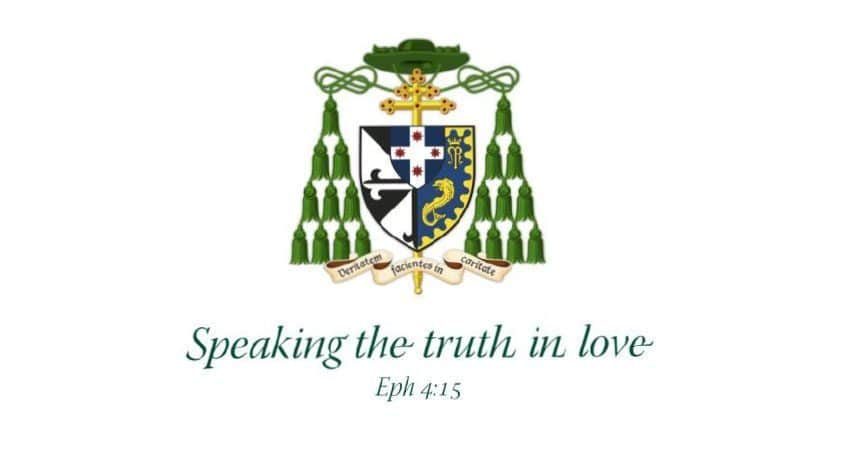Homily for Mass of the 4th Sunday of Advent, Year A

St Mary’s Cathedral, Sydney, 18 December 2022
There are a few contenders for the most iconic line in an Aussie film. Who could forget Paul Hogan as Crocodile Dundee (1986) saying: “That’s not a knife”?[1] Or Farmer Hogget (played by James Cromwell) at the end of Babe (1995): “That’ll do pig, that’ll do”?[2]
But perhaps the most popular Aussie film line, if sheer recitations are anything to go by, are four words uttered by Darryl Kerrigan (played by Michael Caton) in that most affectionate portrayal of Aussie suburbia, the 1997 classic The Castle: “Tell ‘em they’re dreamin’.” In the film Kerrigan uses the phrase whenever his shopaholic son Steve (Anthony Simcoe) mentions the price of an item for sale in the Trading Post. Darryl’s point is simple: only a dreamer would think that price was fair.
Dreamers are often contrasted with those firmly grounded in reality. We dream for about two hours each night while we are asleep, experiencing strange, fantastical, even frightening images and story-lines whether or not we remember them later. To dream while we are conscious is to escape the everyday for the surreal or to reach for the distant, even unattainable goal. Though experts debate the neurophysiological and psychological significance of dreams, many believe they have some deeper meaning. Books, podcasts and gurus claim to decipher dreams and help us apply their wisdom to everyday life. There’s even an Institute of Dream Studies which offers a certificate programme for budding dream experts.[3]
The ancients thought dreams were predictors or controllers of the future. In the Bible God sometimes comes to people in dreams for conversation, directions or warnings;[4] at other times He withholds such counsel.[5] Sometimes dreams and their interpretation are seen as a charismatic gift from God;[6] at other times they are judged by the Bible to be illusory, even deceptive.[7]

Nicolas Dipre, Jacob’s Ladder (c. 1500), Petit Palais Avignon
Long before Joseph Son of Jacob and husband of Mary, there was another Joseph Son of Jacob, one of his ancestors who was also a dreamer. His story is currently being told in a sumptuous new production of Andrew Lloyd Webber’s musical, “Joseph and the Amazing Technicolour Dreamcoat”, playing in Melbourne.[8] It opens with Joseph singing “Any Dream Will Do” and receiving from his father a multi-coloured coat which delights the boy but makes his eleven brothers jealous. When Joseph tells them he has dreamt that he is destined to rule over them all, they are not impressed: they plot his death but actually sell him into slavery (Gen ch. 37). He ends up in prison, dreaming and explaining other prisoners’ dreams (Gen ch. 40). In Act II of the Webber version and the subsequent chapters of Genesis (chs 40-50), Joseph’s fame as an interpreter of dreams reaches Pharoah’s ears and he joins the court, rises to high rank, and eventually wins back his family and his technicolour dreamcoat.
This Joseph’s penchant for dreams may have been genetic: his father Jacob famously dreamt of a ladder between heaven and earth, with angels ascending and descending, a premonition of the Incarnation (Gen 28:10-21; cf. 31:10-16; Jn 1:47-51). Jacob’s grandfather Abraham also had visions of angels and of the great nation that would be his descendants (Gen chs 15-18).
Today we hear the story of Jesus’ origins (Mt 1:18-24). Once again, a dreamer called Joseph bar-Jacob features in the story. It’s the first of four divinely inspired dreams of Joseph recorded by Matthew (Mt 1:20-21; 2:13,19-20,22). The similarities between the two Josephs are no accident. In the immediately preceding verses from Matthew’s gospel (Mt 1:1-17) we hear Joseph’s genealogy onto which Jesus is grafted, and it begins with Abraham, Isaac and Jacob, for Jesus will be the greatest of the many descendants they were promised. God’s promises to the patriarchs are finally coming to fruition in this last dreamy patriarch, Joseph the step-father of Jesus.

A second feature of dreams is the docility of the subject. If we are too sure of ourselves and our own thinking, too attached to our own ways or unable to imagine other possibilities, we may not see God’s ways or may resist them. The dreamer is not in control of the dream: if it’s genuine revelation, God is in control. Of course, God usually communicates His will through Scripture, Church tradition, the magisterium, the saints; private revelations must be measured against those things. But what Joseph exemplifies is docility to God’s will, not irrational suggestibility like a subject of hypnosis. Joseph must still interrogate, think, plan and act: how am I to relate to my wife, protect her and the Babe, find lodgings and safety, work my trade, teach my Son, do Jerusalem for the feasts? All the while, then, Joseph is open while engaging both his faith and reason.
A third reason for this dreamy form of messaging is its transformative power. When God communicates messages through dreams in the Bible, the recipient usually experiences a profound change of heart and responds immediately on waking up. Prior to his dreams, Abram was unsure of his future and of how to act in the present; after them, he responded in faith wholeheartedly. His grandson Israel-Jacob followed his own ambition and thinking when he stole his father’s blessing and his brother’s place in the line; but after his dream he trusted only in God’s promises and accepted his responsibilities in God’s plan.

In today’s Gospel it is Joseph’s turn to demonstrate identity, docility and mission. He’s just found that his betrothed is with child and not by him. He’s decided to do what justice requires, divorcing her and so protecting his honour; but also to do what mercy invites, separating from her “informally” so her honour is also protected. Yet following the angel’s revelation in his dream, he abandons this plan, and substitutes for the logic of the world the ways of the divine, trusting in the way of God’s dreamers. He takes Mary to his heart and hearth (Mt 1:24).
A fourth and last point about Joseph as dreamer. Like his ancestral namesake, Joseph is the recipient of wonderful news. His wife-to-be is both Virgin and Mother; his Child both Saviour and Presence; and the Holy Spirit will surround them throughout. The prophet Isaiah, as we heard in our first reading, had had a similar vision (Isa 7:10-14): now it was being fulfilled.
So listen now, House of Sydney: the Virgin has conceived and will soon give birth to a Son, who we will call “Emmanuel”—God with us, “Son of Man”—God one of us”, “Jesus”—God saving us. We dream of His coming and pray: O come, O come Emmanuel.
[1] https://www.youtube.com/watch?v=WWl8EbNN8NM
[2] https://www.youtube.com/watch?v=rjQtzV9IZ0Q
[3] https://institutefordreamstudies.org/dream-certification-program-details/
[4] Gen 20:3-7; 31:24; 40:9-19; ch. 41; Num 12:6; Judg 7:13-14; 1Kgs 3:5-15; Job 33:14-18; Mt 2:12; 27:19.
[5] 1Sam 28:15.
[6] Dan 1:17; chs 2, 4 & 7; Joel 2:28; Acts 2:17.
[7] Erel Shalit, “Dreams in the Old Testament,” Encyclopedia of Psychology and Religion (2014)
[8] Dt 13:1-3; Eccles 5:7; Isa 29:7-8; Jer 23:32; Zech 10:2. See also https://www.spectator.com.au/2022/12/the-intensity-of-christmas/
Introduction to Mass of the 4th Sunday of Advent, Year A
St Mary’s Cathedral, Sydney, 18 December 2022
Welcome to St Mary’s Cathedral in Sydney for the Solemn Mass of the Fourth Sunday of Advent. The Virgin is heavily pregnant and has begun her journey to the little town of Bethlehem. A week from now she will bring forth God’s greatest gift to humanity, God Himself in the Child Jesus. As we enter this final strait, we take stock of the mangers of our hearts, sweeping them clean in readiness to receive the Babe of Bethlehem, by repenting of our sin…

